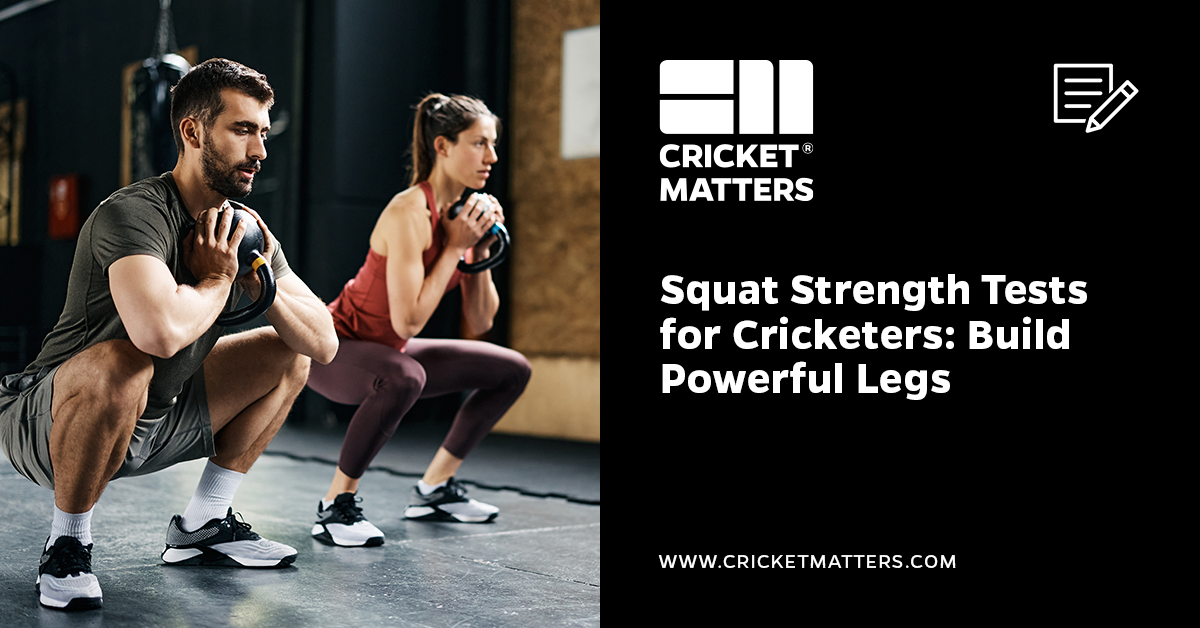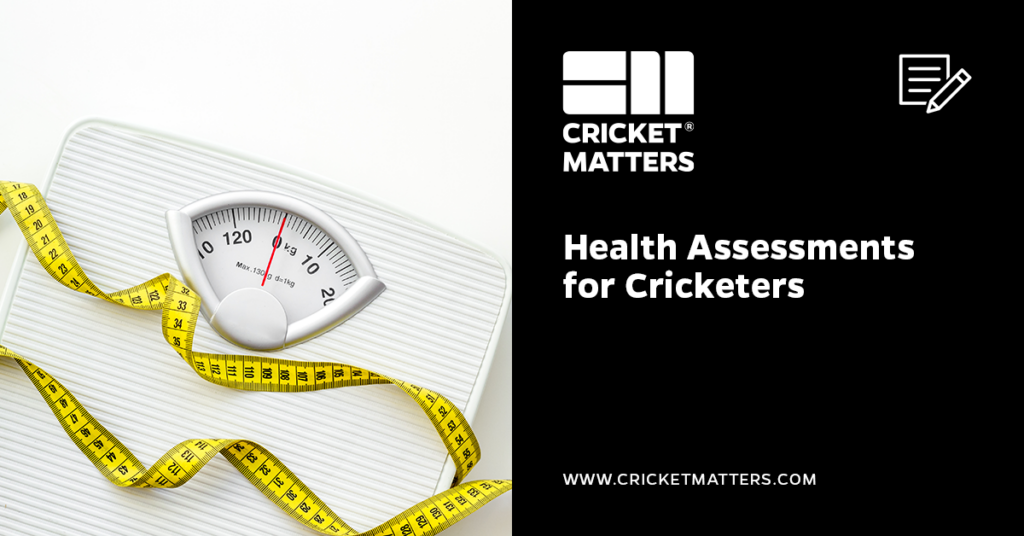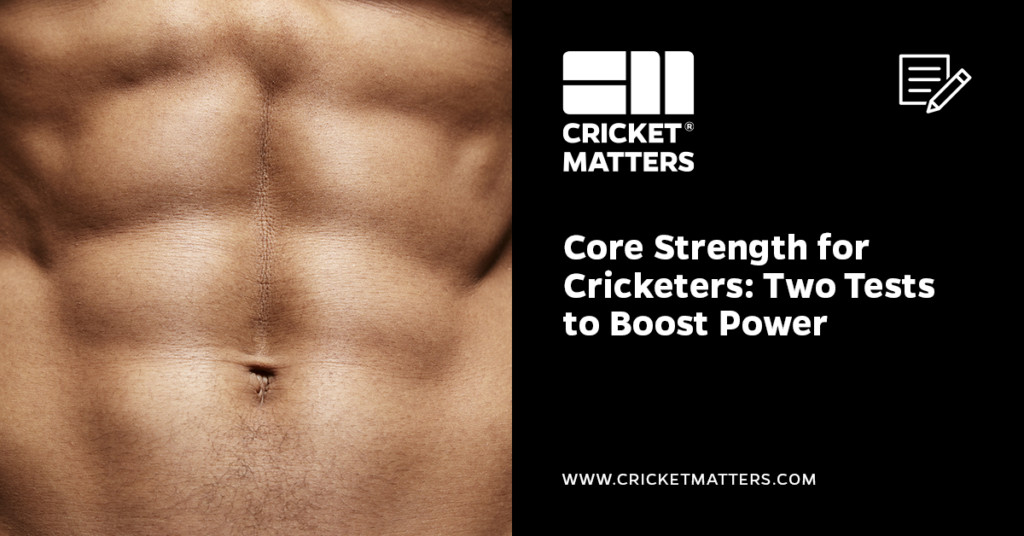
I hope you enjoy reading this blog post.
James Breese, Cricket Matters FounderIf you need my help with cricket coaching, strength and conditioning, injury rehab, or nutrition, click here.
If you want to hit big sixes, bowl fast, or dive for that impossible catch—you need powerful legs.
Ask any elite athlete what separates the best from the rest, and they’ll tell you the same thing: the legs are the foundation of explosive performance.
At Cricket Matters, one thing stands out repeatedly when analysing our athletes—the biggest hitters and fastest bowlers all share one trait: incredibly powerful legs.
But here’s the thing—there are massive discrepancies.
Some players can generate force from their lower bodies, while others lack the strength to reach their full potential.
You can’t be explosive without strong, powerful legs—batting, bowling, or fielding.
Building that power doesn’t just happen overnight. It’s not enough to hit the gym; you need a structured plan that addresses mobility, strength, and stability.
We’ve developed a squat strength testing progression designed specifically for cricketers.
These tests evaluate your lower body strength, reveal performance gaps, and help you unlock explosive power.
In this blog, we’ll explore the critical steps for developing powerful legs and explain how our Performance Analysis goes beyond testing strength—it builds the foundation for resilience, efficiency, and elite-level performance.
We use a three-tiered squat testing progression to evaluate and develop your lower body strength systematically.
Each tier focuses on specific benchmarks to ensure you’re building strength safely and effectively:
- Tier 1: 25% of body weight for 25 reps in a Goblet Squat. This foundational test focuses on endurance, mobility, and technique—laying the groundwork for heavier loads.
- Tier 2: 50% of body weight for 25 reps in a Goblet Squat. This stage builds strength and endurance under greater load while testing your ability to maintain form and resist fatigue.
- Tier 3: 75% of body weight for eight reps in a single-leg Rear-Foot Elevated Split Squat (RFESS). This advanced test measures unilateral power, balance, and stability—essential traits for explosive performance in cricket.
These tests are more than just benchmarks—they’re a progression that mirrors the demands of the game.
By working through each tier, you can see exactly where you stand, how you compare to the pros, and what you need to focus on to take your performance to the next level.
Table of Contents
Why Lower Body Strength Matters for Cricketers
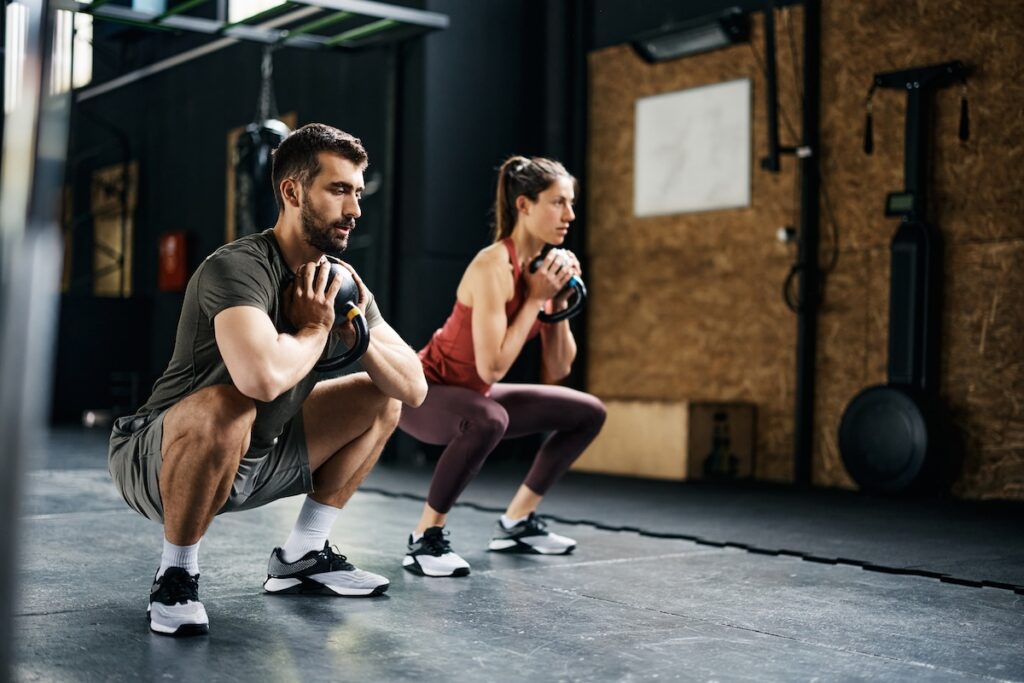
The Role of Lower Body Strength in Cricket
Your lower body is the engine behind every movement in cricket.
Whether charging in to bowl fast, smashing boundaries, or sprinting between the wickets, your legs provide the power and stability needed to perform.
Without strong lower limbs, your ability to generate force, stay balanced, and remain agile diminishes, directly affecting your performance.
The muscles in your lower body—quadriceps, hamstrings, glutes, and calves—work together to stabilise your body, generate explosive force, and control movement.
In cricket, where every action demands precision and power, the importance of lower body strength cannot be overstated.
Power and Stability
Every explosive movement in cricket begins with the legs.
Bowling speed, for example, relies on the energy generated from a bowler’s run-up and delivery stride.
The lower body provides the foundation to transfer this force efficiently through the hips, core, and arm.
Similarly, batting power comes from the ability to drive through the lower body, transferring energy from the ground into the bat.
Without this solid base, shots lack the power to clear the boundary.
Lower body strength ensures stability during these high-intensity actions, enabling cricketers to stay controlled while generating maximum force.
Squats are more than just an exercise for building strength—they’re a key to unlocking an athlete’s ability to generate explosive power and maintain stability under pressure.
— Dr. Stuart McGill, Spine Biomechanics Expert
Balance and Coordination
Cricket isn’t just about brute strength—it demands balance and control.
Single-leg strength is vital in maintaining stability during dynamic movements like diving, lunging, or bowling.
Exercises like the Rear-Foot Elevated Split Squat (RFESS) build unilateral strength, helping cricketers stay balanced during asymmetrical movements.
Addressing imbalances between the left and right sides improves coordination and reduces compensations, allowing for more fluid and efficient actions on the field.
Injury Prevention
Weak lower body muscles cause cricket-related injuries, such as hamstring strains, knee instability, and lower back pain.
These injuries often result from cricket movements’ repetitive and high-impact nature, particularly for bowlers and fielders.
Strong lower body muscles act as a protective framework for the joints and smaller supporting structures, absorbing impact and reducing strain.
For instance, strength-focused exercises like Nordic hamstring curls are highly effective in reducing hamstring injuries, a common issue among cricketers.
Building lower body strength helps you stay fit and resilient across a demanding season.
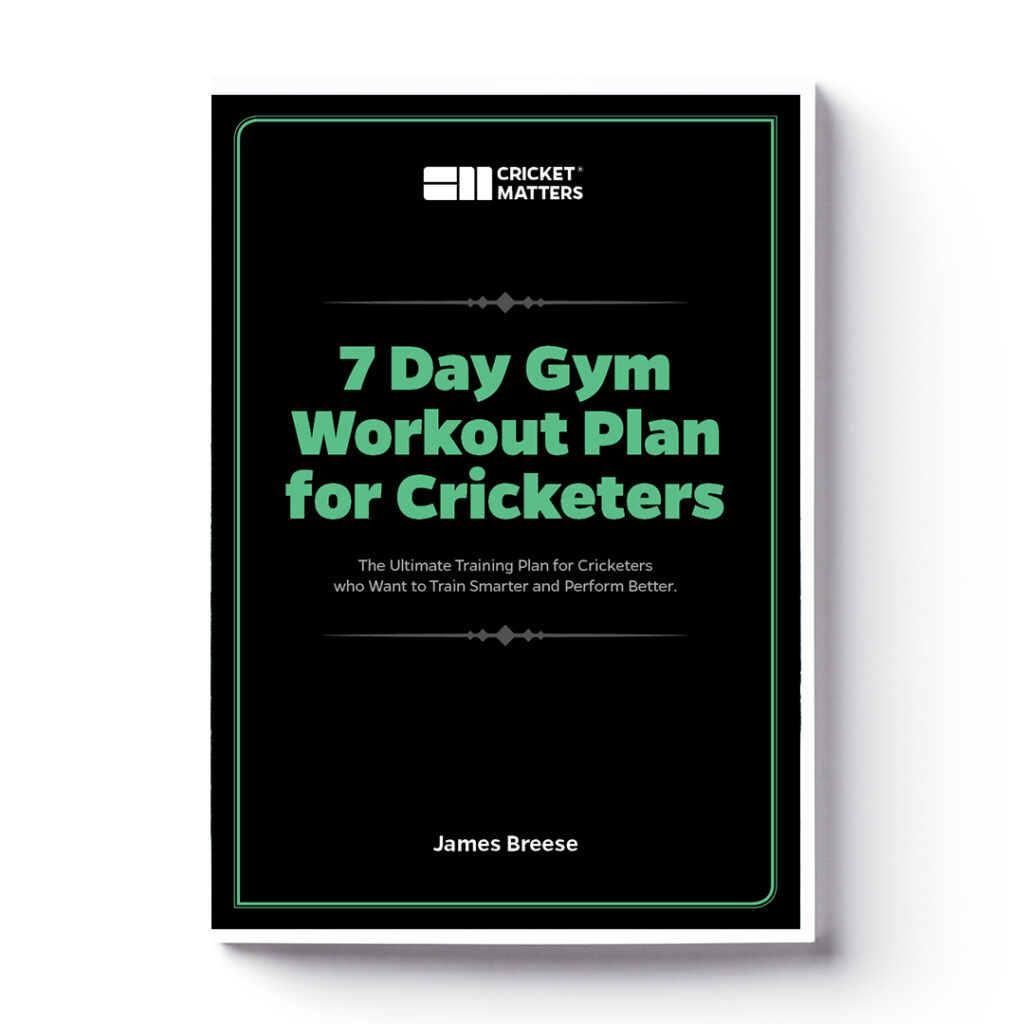
Have You Downloaded Our FREE 7-Day Gym Workout Plan?
Grab your complete step-by-step 7-day gym workout plan for cricketers today. There will be no more Guesswork. Just follow the plan and get results.
Data-Driven Insights on Lower Body Strength for Cricketers
Scientific research highlights the importance of lower body strength across a variety of performance metrics:
- Sprint Performance: Increased lower-body strength improves sprint performance, enhancing running speed—a crucial skill for quick singles and fielding (Seitz et al., 2014).
- Change of Direction: Lower limb maximal and explosive strength are key predictors of agility and change-of-direction performance, essential for fielding and running between the wickets (Spiteri et al., 2014).
- Injury Prevention: Strength-focused exercises, such as Nordic hamstring curls, significantly reduce hamstring injury rates, improving athletic longevity (Mjolsnes et al., 2004).
Cricket-specific studies further reinforce these findings:
- Bowling Performance: Plyometric and complex training programs improve lower limb power, directly increasing bowling speed and overall effectiveness (Ali et al., 2023).
- Functional Training Benefits: Short-term functional training programs enhance lower body strength and power, leading to better sprinting and agility performance on the field (Kumar et al., 2024).
What This Means for Cricketers
Lower body strength is the foundation for every action in cricket. Whether batting, bowling, or fielding, your legs drive performance, giving you the power, balance, and resilience to excel.
At Cricket Matters, we understand that improving your game starts with building a strong base.
That’s why our Level 1 – Level 3 Performance Analysis includes a structured progression of squat strength tests—designed to identify weaknesses, set benchmarks, and guide you toward unlocking your full athletic potential.
By strengthening your lower body, you’ll increase your power and agility and protect yourself from injuries, ensuring a long and successful cricketing career.
The Cricket Matters Squat Progression Framework
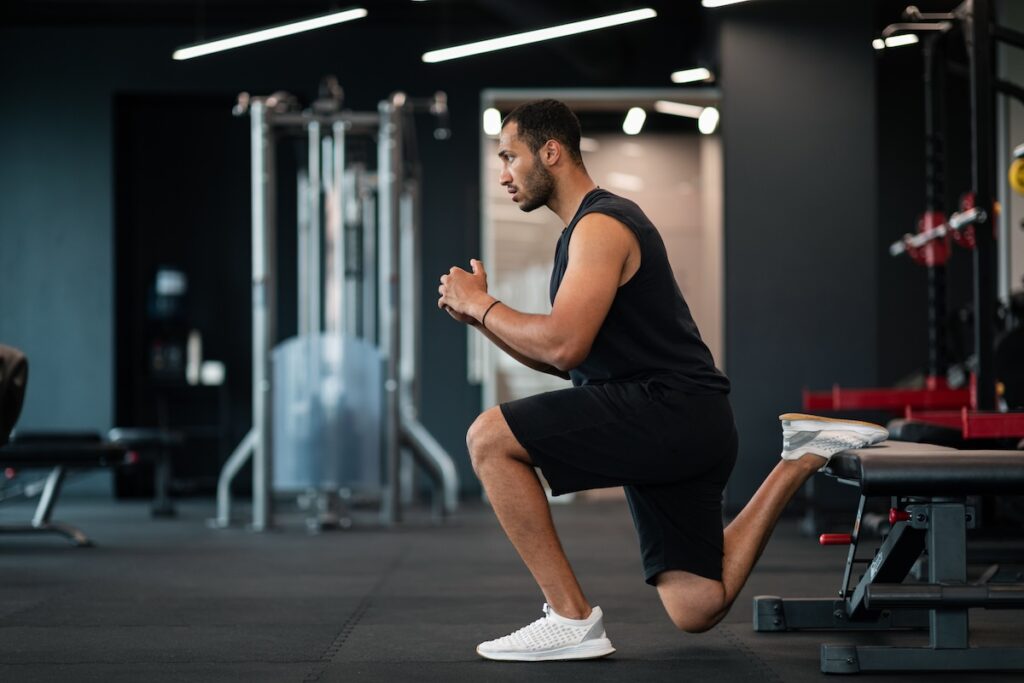
At Cricket Matters, we’ve crafted a three-stage squat progression framework that doesn’t just focus on building strength—it ensures every cricketer develops the movement quality, stability, and cricket-specific functionality required to excel on the field.
Why We Prioritise Movement Quality Over Raw Strength
In our experience, reliance on barbell squats for strength building often leads to unnecessary injuries.
Barbells are effective for building strength, but for cricketers already managing spinal stress from bowling or long batting stints, they can do more harm than good. Put simply, with the bar, the ball always wins.
Instead, we focus on unilateral movements and progressive loading that build strength safely, mirroring cricket’s asymmetrical demands.
This philosophy aligns with research from Alex Natera and others, who have shown that single-leg exercises like the RFESS can achieve equal or superior results to barbell training without the associated risks of spinal compression or dysfunctional loading.
Our Three-Tier Squat Progression Framework

This framework reflects our commitment to safe, functional, and effective strength training, building progressively from bilateral endurance work to heavy unilateral strength development.
Stage 1: Bilateral Goblet Squat (25% Body Weight, 25 Reps)
This is where every athlete begins. With a manageable load (e.g., 20kg for an 80kg athlete), the focus is on:
- Endurance and Mobility: High reps help develop muscular endurance and ensure athletes can sustain movement during long matches.
- Technique Mastery: The lighter loads let athletes focus on squat mechanics, including depth, alignment, and joint mobility.
- Baseline Testing: This stage highlights any mobility restrictions or compensations that must be addressed before heavier loading.
Purpose in Performance Analysis: This phase ensures that every athlete has a solid foundation before progressing. If movement dysfunction is detected here, we work to correct it first.
Stage 2: Bilateral Goblet Squat (50% Body Weight, 25 Reps)
Once athletes master the basics, we increase the load to 50% of body weight (e.g., 40kg for an 80kg athlete). This phase bridges the gap between endurance and strength:
- Strength Endurance: Handling higher loads for 25 reps builds the ability to maintain power throughout a match, particularly during long bowling spells or batting innings.
- Core Stability: Increased load demands greater torso stability, crucial for preventing injuries and maintaining balance under pressure.
- Consistency Under Fatigue: This stage tests the athlete’s ability to maintain proper form even as fatigue sets in.
Purpose in Performance Analysis: This stage identifies athletes who can handle increased demands without breaking form, setting the stage for advanced strength development.
Stage 3: Unilateral Rear-Foot Elevated Split Squat (RFESS, 75% Body Weight, 8 Reps Per Leg)
The final stage transitions athletes to single-leg work, reflecting the asymmetrical nature of cricket movements like bowling, sprinting, and diving. With 75% of body weight (e.g., 60kg for an 80kg athlete), this phase prioritises:
- Maximal Unilateral Strength: The heavier load develops explosive power critical for fast bowling, sprinting between wickets, and hitting big shots.
- Balance and Stability: Single-leg work challenges neuromuscular coordination and balance, reducing compensations and injury risk.
- Cricket-Specific Application: By replicating the one-leg push-off used in most cricket actions, the RFESS ensures strength gains translate directly to on-field performance.
Purpose in Performance Analysis: This stage highlights imbalances between legs and evaluates the athlete’s capacity for maximum strength under cricket-specific conditions.
If you’re not doing single-leg training, you’re not training athletes.
– Mike Boyle
Why Single-Leg Movements Are Essential

Research consistently shows that single-leg exercises place significantly greater demands on the working leg than bilateral movements. According to findings published on ResearchGate:
- Force Differences: Single-leg movements generate 1.62 times greater force acting on each leg than during a bilateral squat.
- Load Adjustments: To match the effort of a single-leg movement, an athlete would need to triple the external load on a bilateral squat.
Example: 80kg Athlete Comparison
- Bilateral Squat: An athlete holding 20kg dumbbells in each hand (40kg total) during a bilateral squat distributes the load equally between both legs. Each leg handles 60kg (body weight + external load).
- Single-Leg RFESS: The same athlete performing the RFESS with 40kg external load places 107kg (84% of body weight + external load) on the working leg.
This demonstrates why single-leg movements are so effective for building strength and why our programme prioritises them for advanced training stages.
They demand significantly more effort from the working leg, ensuring strength gains are functional, balanced, and directly applicable to cricket.
Why This Framework Works for Cricketers
Our progression framework doesn’t just build strength—it builds strength with purpose. Here’s why it’s so effective:
- Movement First: By prioritising movement quality over weight, we reduce injury risks and ensure every athlete progresses safely. We don’t add load to dysfunction.
- Cricket-Specific Focus: Single-leg movements replicate the asymmetrical demands of cricket, ensuring strength gains and improved performance on the field.
- Strong Enough is Strong Enough: We focus on developing practical, game-ready strength—not chasing arbitrary numbers in the gym.
- Targeted Corrective Work: Each framework stage reveals weaknesses or imbalances, allowing for targeted interventions that build long-term resilience.
This framework is more than a testing protocol—it’s a roadmap for building powerful legs, injury resilience, and explosive performance.
Benchmarking and Advanced Analysis: Lessons from Cricket, Baseball, and Golf
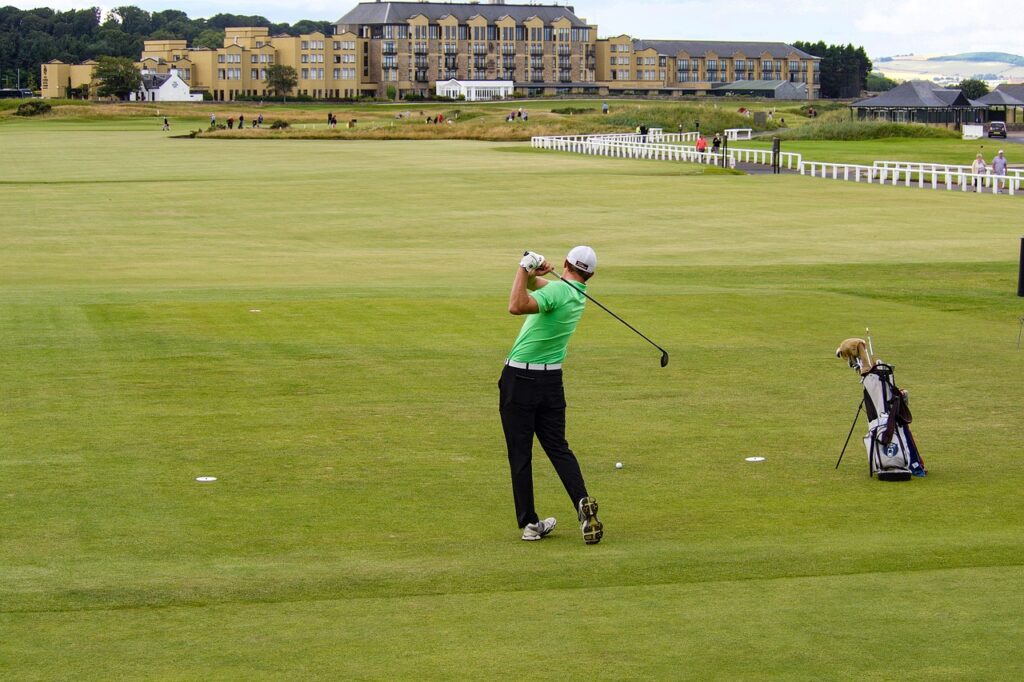
Building lower body strength isn’t just about ticking boxes—it’s about turning benchmarks into real-world performance gains on the cricket field.
Insights from cricket, baseball, and even golf underscore how progressive strength training transforms athletic performance, particularly the shift from bilateral to unilateral movements.
Why It Matters for Cricket Performance
Bowling Speed:
A fast bowler’s power starts in the legs, where strength and stability provide the foundation for explosive speed.
The kinetic chain begins with ground reaction forces, which transfer through the legs to the upper body.
Research shows that unilateral exercises like the Rear-Foot Elevated Split Squat (RFESS) enhance leg strength and improve balance and stability—both critical for optimising the delivery stride (Alghadir et al., 2023).
Stronger legs mean more efficient energy transfer, resulting in faster, more accurate deliveries.
Hitting Power:
Like baseball, where lower body power drives harder swings, cricket relies on strong legs to generate the rotational force needed to smash boundaries.
Studies on youth baseball players found a direct correlation between lower body power and hitting performance (Agee et al., 2023).
For cricketers, stronger legs lead to a more powerful, more efficient player, enabling players to capitalise on scoring opportunities more efficiently.
Fielding Explosiveness:
Dynamic movements like sprinting, diving, or sudden direction changes demand single-leg strength and balance.
Building this through unilateral exercises prepares cricketers for the asymmetrical demands of the game, enhancing agility while reducing the risk of injury.
A strong lower body ensures cricketers can field longer and more efficiently under match-day pressures.
The Golf Connection: Insights on Power Transfer
Golf research has revealed parallels with cricket, a sport that relies heavily on lower body power for driving distance.
Like the rotational force in a golfer’s swing, the cricket bat relies on strong, stable legs to anchor and transfer power.
Golf research shows that explosive strength training—such as plyometrics and unilateral drills—results in measurable gains in clubhead speed and driving distance (University of Pittsburgh).
This aligns with cricket’s demand for explosive strength to optimise hitting power and bowling speed.
Lower body strength is the foundation of power in the golf swing. Without a strong and stable base, it’s impossible to generate the speed and force needed for optimal performance.
Dr. Greg Rose, Titleist Performance Institute
How We Incorporate This in Performance Analysis
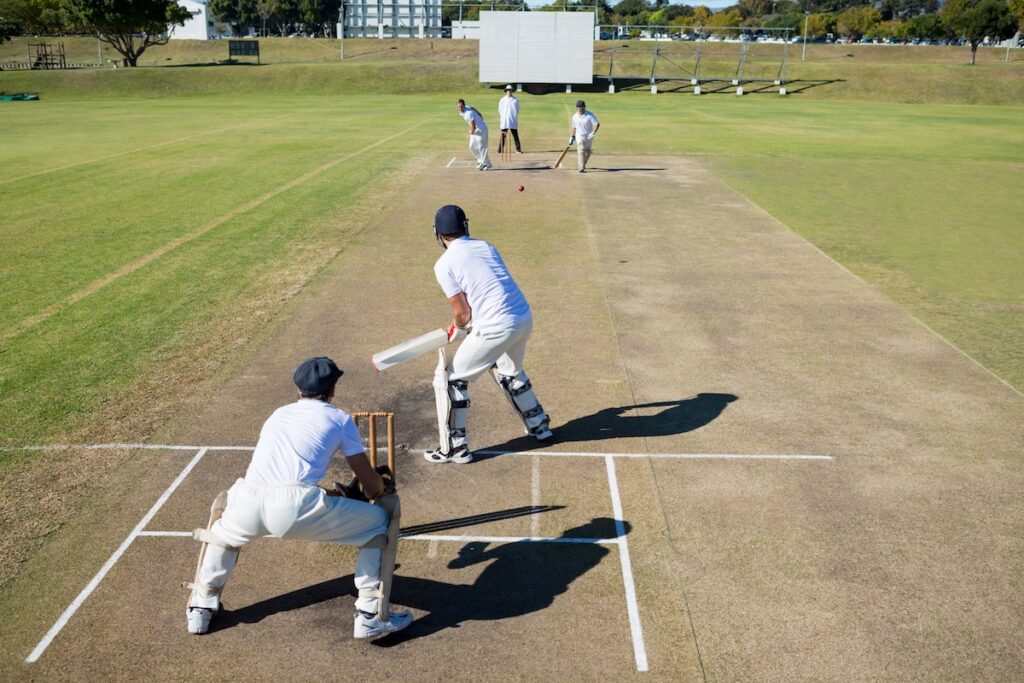
At Cricket Matters, our three-stage squat progression framework combines lessons from sports science with cricket-specific demands.
Here’s how we assess and build lower body strength to prepare athletes for elite performance:
- Stage 1: Bilateral Goblet Squat with 25% Body Weight
This foundational stage focuses on endurance, mobility, and mastering proper form. It builds the muscular and cardiovascular capacity needed for intense matches while creating the foundation for safe strength progression. - Stage 2: Bilateral Goblet Squat with 50% Body Weight
This stage tests strength under fatigue by increasing the load while maintaining endurance. Athletes build resilience and core stability, simulating the demands of match-day situations like long bowling spells or extended batting stints. - Stage 3: Rear-Foot Elevated Split Squat (RFESS) with 75% Body Weight
The final stage focuses on single-leg strength, balance, and explosive power. These movements mirror cricket-specific actions, such as front leg landing on delivery or sprinting between the wickets. We address imbalances by building strength one leg at a time while enhancing overall performance.
The Numbers That Matter
Single-leg movements demand significantly more effort than double-leg exercises.
Research shows that a single-leg exercise requires up to 1.62 times the force per leg compared to double-leg movements (Natera et al., 2023).
For example, an 80 kg athlete squatting with 20 kg dumbbells in each hand during an RFESS produces the equivalent force of squatting over 140 kg with a barbell on the back.
This highlights why unilateral exercises are safer for cricketers and more effective for building sport-specific strength.
Why This Approach Works
- No Loading Dysfunction: We prioritise movement quality over numbers. Athletes don’t progress until they demonstrate perfect form, reducing injury risks and ensuring long-term strength gains.
- Strong Enough is Strong Enough: We focus on building strength levels that support cricket performance, not just lifting heavy for the sake of it.
- Cricket-Specific Training: Unilateral exercises replicate the asymmetrical demands of cricket, building strength and stability that translate directly to on-field performance.
Real-World Results
Our framework isn’t just about strength—it’s about preparing athletes to bowl faster, hit harder, and field athletically.
By setting clear benchmarks and ensuring each athlete masters the fundamentals before progressing, we create a pathway to advanced performance analysis.
This includes integrating movement quality, mental resilience, and cricket-specific skills to elevate their game.
Whether you’re aiming to increase bowling speed, dominate with the bat, or cover ground in the field, powerful legs are the foundation.
With the Cricket Matters progression system, you’ll build strength, resilience, and efficiency, ensuring you stay at the top of your game throughout the season.
Don’t add strength to dysfunction. Movement quality is the foundation of athletic performance, and every step forward should be built on solid, functional movement patterns.
Gray Cook, Functional Movement Systems (FMS)
Corrective Squat Programs Based on Results
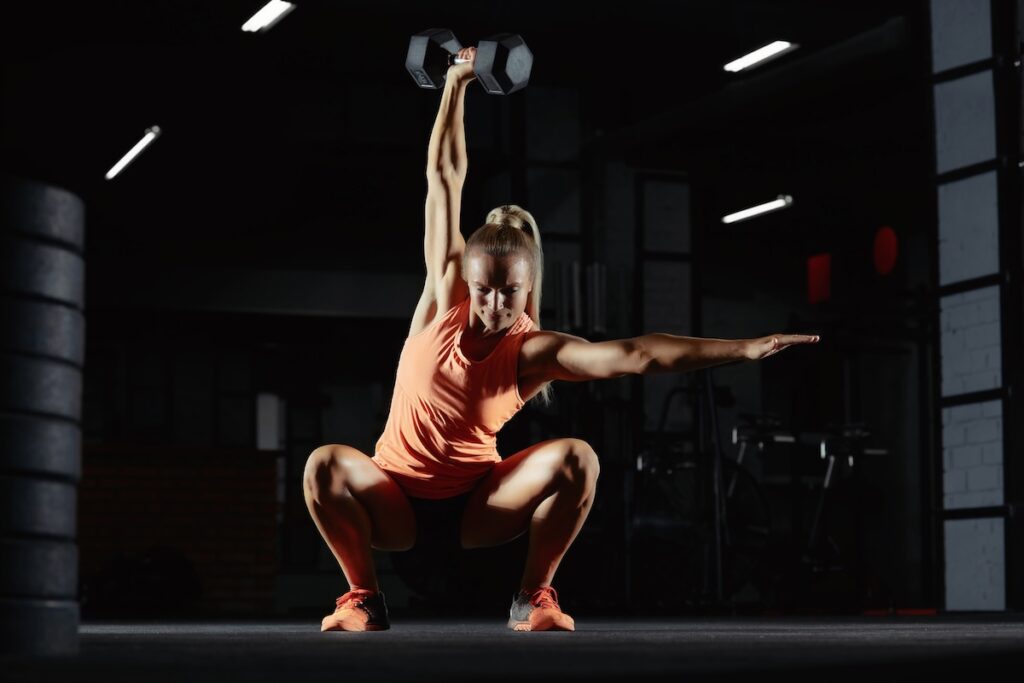
At Cricket Matters, our squat progression framework doesn’t just measure strength—it identifies key areas for improvement, ranging from mobility and motor control to endurance and unilateral power.
Correcting these issues is essential for improving cricket performance, building resilience, and reducing injury risk.
Stage 1 Deficiencies: Weak Endurance, Poor Technique, or Mobility and Motor Control Issues
The first stage often uncovers fundamental weaknesses, such as a lack of muscular endurance, improper squatting mechanics, or limited mobility and motor control.
These issues are common, especially in athletes new to structured strength training or those with ingrained movement patterns.
Corrective Exercises and Strategies:
- Mobility Work: Tight hips or ankles can prevent athletes from achieving proper squat depth or maintaining good form. Focus on:
- Ankle Dorsiflexion Drills: Exercises like wall knee-to-toe taps improve ankle flexibility.
- Hip Mobility Exercises: Use 90/90 hip stretches or banded hip flexor stretches to increase the range of motion.
- Motor Control Drills: Athletes struggling with movement coordination can benefit from:
- Bodyweight Tempo Squats: Slowing down the squat helps athletes focus on smooth, controlled movement.
- Assisted Squats (TRX or Stability Ball): Supportive tools help refine movement patterns without compensatory strategies.
- Goblet Squats: This staple exercise reinforces the correct squatting technique while teaching athletes to maintain an upright torso and proper depth.
- Core Stabilisation Exercises: Weak core muscles often contribute to poor squat mechanics. To develop stability, incorporate planks, dead bugs, and bird dogs.
Cricket-Specific Improvements: Addressing Stage 1 deficiencies allows cricketers to achieve a stable and balanced lower body foundation, which is critical for batting, long bowling spells, and enduring match fatigue. Improved mobility and motor control lead to smoother and safer movement patterns under game-day stress.

Have You Downloaded Our FREE 7-Day Gym Workout Plan?
Grab your complete step-by-step 7-day gym workout plan for cricketers today. There will be no more Guesswork. Just follow the plan and get results.
Stage 2 Challenges: Fatigue Resistance and Strength Under Load
Athletes who struggle at Stage 2 often face difficulties maintaining form as fatigue sets in or handling increased loads. These challenges highlight gaps in strength endurance and core stability.
Corrective Exercises:
- Tempo Squats: By slowing the eccentric (lowering) phase, athletes build better control and improve muscle activation under load.
- Bulgarian Split Squats: These introduce unilateral demands while improving strength, endurance, and balance, bridging the gap to Stage 3.
- Progressive Loading Strategies: Increase weights incrementally while maintaining high-quality movement to build strength and endurance safely.
Cricket-Specific Improvements: Strengthening endurance at this stage prepares athletes for prolonged match scenarios. Bowlers gain the stamina to maintain their pace across multiple overs, while batters and fielders benefit from the ability to stay dynamic late into games.
Stage 3 Gaps: Unilateral Strength and Stability
Deficiencies at Stage 3 are often tied to imbalances between legs, poor stability, or limited single-leg strength.
These gaps can significantly hinder performance in cricket-specific movements like bowling strides, running between wickets, or diving fielding actions.
Corrective Exercises:
- Step-Ups: Mimic the unilateral force production required in movements like sprinting or stepping into a bowling stride.
- Single-leg Romanian Deadlifts (RDLs) Build posterior chain strength and balance, which are key to efficient force transfer during cricket actions.
- RFESS Heavey Progressions: To build unilateral strength and stability, we start adding more load as movement quality improves.
Cricket-Specific Improvements: Correcting Stage 3 gaps enables athletes to produce more power and control in asymmetrical movements, resulting in faster bowling speeds, harder hitting, and more athletic cricketers.
Practical Application for Cricketers
Here’s how addressing these deficiencies translates directly into cricket performance:
- Increased Bowling Power: Improved mobility and unilateral strength from exercises like RFESS and single-leg RDLs can make bowlers faster.
- Explosive Batting Power: Improved lower body strength and mobility enable batters to generate more force in their shots, maintain balance through powerful strokes, and stay controlled even during long innings under fatigue.
- Dynamic Fielding Ability: Addressing imbalances and developing agility leads to quicker, more explosive dives and sprints, reducing errors in the field.
Cricket Matters ensures athletes meet benchmarks and excel in cricket-specific demands by prioritising mobility, motor control, and movement quality alongside strength.
This approach reduces injury risk while maximising potential and preparing cricketers to dominate on the field with strength, balance, and athleticism.
If you don’t address mobility and stability first, you’re just building strength on top of dysfunction—and that’s a recipe for injury.
– Mike Boyle, Strength and Conditioning Coach
The Benefits of a Structured Progression: Building a Complete Cricketer
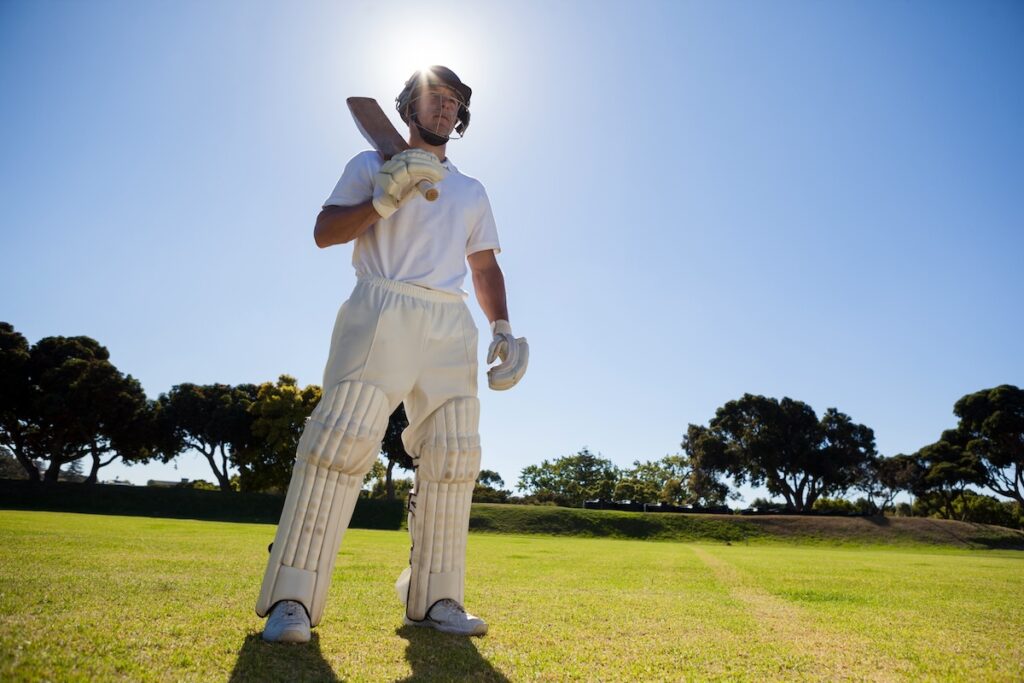
A well-designed progression isn’t just about ticking boxes; it’s about systematically developing all the physical attributes needed for cricket performance—strength, endurance, balance, and mobility—while minimising injury risk and maximising output on the field.
Comprehensive Development
Each stage of the Cricket Matters Squat Progression Framework is designed to build specific attributes that support cricket performance:
- Strength: Starting with bilateral goblet squats and moving to unilateral RFESS ensures a solid foundation and maximises functional lower body strength.
- Endurance: High-rep sets in Stages 1 and 2 enhance muscular endurance, critical for staying powerful through long matches.
- Balance and Stability: The shift to unilateral exercises in Stage 3 ensures athletes can control their movements during asymmetrical cricket actions like bowling or sprinting.
- Mobility: Each stage emphasises mobility, ensuring players can move freely through their full range of motion—essential for explosive actions like fast bowling or powerful strokes.
By focusing on these areas step-by-step, athletes develop their full athletic potential without skipping crucial building blocks.
Injury Prevention
The gradual nature of this framework plays a pivotal role in reducing the risk of injuries, a key concern for cricketers who often deal with lower back pain, hamstring strains, and knee instability.
- Controlled Progression: Research has shown that structured loading minimises overuse injuries by giving the body time to adapt to increasing demands (Mjolsnes et al., 2004).
- Targeted Weaknesses: Each stage exposes areas of dysfunction—such as poor mobility or imbalances—and addresses them before allowing progression, ensuring athletes don’t compensate with improper movement patterns.
- Core Integration: Lower body strength developed alongside core stability reduces stress on the lower back during repetitive bowling or batting actions, keeping athletes on the field longer.
Performance Enhancement
The true test of a progression lies in its impact on performance, and this framework delivers.
- Speed and Power: Improved lower body strength translates to faster sprinting, quicker reaction times, and more explosive power in both bowling and hitting. For example, research has linked greater unilateral strength to increased bowling speed and harder batting strikes (Ali et al., 2023).
- Fatigue Resistance: Enhanced endurance ensures cricketers can maintain their performance over prolonged matches, reducing the likelihood of errors caused by exhaustion.
- Resilience: Better balance and stability from unilateral work allow athletes to handle dynamic match scenarios, such as diving for catches or pivoting during aggressive running, with less risk of injury.
Research-Driven Success
A study by Kumar et al. (2024) demonstrated that cricketers who incorporated structured lower-body strength progressions, including unilateral movements, improved sprinting speed and agility by over 15%.
Similarly, athletes with balanced bilateral and unilateral strength scores were 30% less likely to experience non-contact injuries during a season (De Blaiser et al., 2017).
The Takeaway
A structured progression like the Cricket Matters Squat Framework doesn’t just build strong legs—it creates resilient, agile, and powerful cricketers who can dominate every aspect of the game.
By ensuring that athletes move well, train effectively, and progress intelligently, we set them up for long-term success on the cricket field.
Key Takeaways: Why Lower Body Strength Is Non-Negotiable for Cricketers
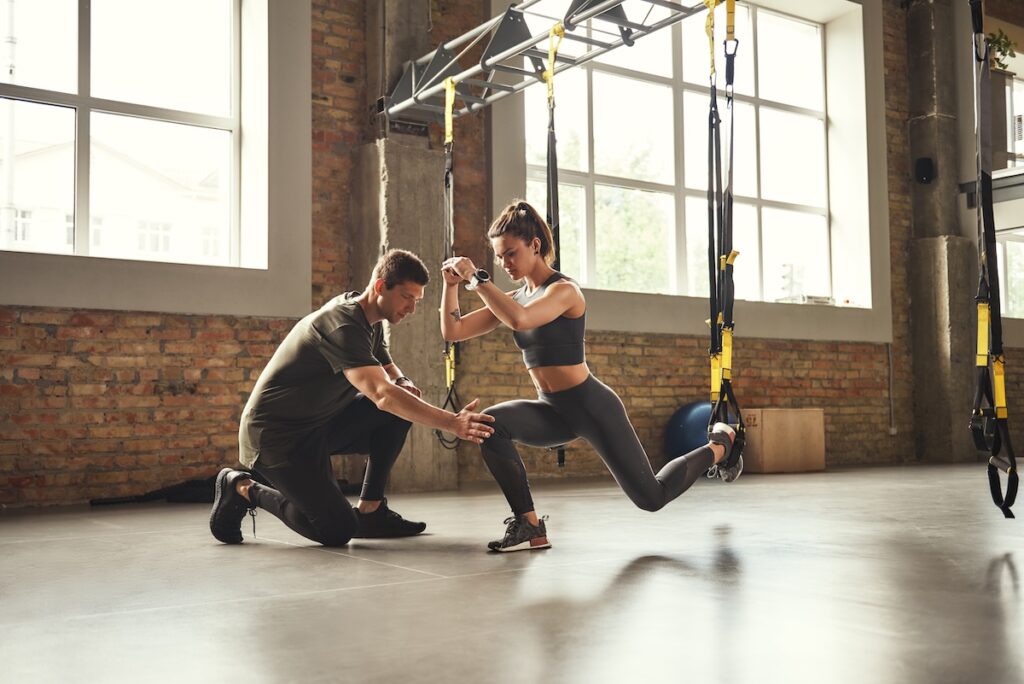
Lower body strength isn’t just another box to tick—it’s the foundation for every explosive movement on the cricket field.
Without it, you can’t bowl faster, hit harder, or move with the agility needed to be a great player.
The Cricket Matters Squat Progression Framework shows how systematic testing and structured progression can build strength that directly translates to cricket performance.
Each stage evaluates your current status and sets a clear path for improvement, ensuring you develop strength in a safe, balanced, and sport-specific way.
Whether you’re a batter looking to generate more power, a bowler aiming for that extra bit of pace, or a fielder striving for better agility, lower body strength will give you the edge.
It’s not just about lifting heavier weights—it’s about moving better, staying resilient, and performing at your peak when it matters most.
The biggest takeaway? Leg strength is non-negotiable.
Build it right, and you’ll see the difference in every aspect of your game.
With the right approach, explosive performance is within your reach. The question is: Are you ready to take the next step?
Ready to Take Your Game to the Next Level?
Book your Performance Analysis today and gain insights into every aspect of your game.
Our comprehensive approach will transform your cricket performance from core stability to mental resilience and technical precision.

Have You Downloaded Our FREE 7-Day Gym Workout Plan?
Grab your complete step-by-step 7-day gym workout plan for cricketers today. There will be no more Guesswork. Just follow the plan and get results.
Further Reading
FAQ’s
Why Is Lower Body Strength Important for Cricketers?
Lower body strength is the foundation for nearly every movement in cricket. Whether a bowler bowls fast, a batter smashes the ball to the boundary, or a fielder sprints and dives, the legs generate the power and stability required for these actions. Strong quadriceps, hamstrings, glutes, and calves ensure efficient force transfer, balance, and agility. Without sufficient lower body strength, cricketers may struggle with performance consistency, fatigue, and a higher risk of injury during intense match situations.
What Is the Cricket Matters Squat Progression Framework?
The Cricket Matters Squat Progression Framework is a three-stage system designed to assess and build lower body strength safely and effectively. It starts with a Bilateral Goblet Squat at 25% of body weight for 25 reps, focusing on endurance, mobility, and technique. Stage 2 increases the load to 50% of body weight for 25 reps to test strength endurance and fatigue resistance. Finally, Stage 3 progresses to the Rear-Foot Elevated Split Squat (RFESS) with 75% of body weight for 8 reps per leg, targeting unilateral strength, balance, and stability. This structured progression ensures that cricketers build strength specific to their on-field demands.
How Does Single-Leg Training Improve Cricket Performance?
Single-leg training mimics the asymmetrical movements in cricket, such as bowling strides, batting pivots, and sprinting between wickets. Exercises like the RFESS develop unilateral strength, helping to address imbalances between legs, improve stability, and enhance neuromuscular control. During cricket-specific actions, this translates to greater power, precision, and injury resilience. Research shows that single-leg exercises are more demanding on the working leg, making them highly effective for building functional strength.
How Does Lower Body Strength Reduce Injury Risk in Cricket?
Strong lower body muscles act as a protective framework for the joints, absorbing shock and reducing strain during high-impact movements. For bowlers, lower body strength helps stabilise the delivery stride, minimising stress on the knees and lower back. It improves balance and coordination for batters and fielders, reducing the likelihood of falls or missteps. Exercises like Nordic hamstring curls and single-leg squats have been proven to reduce common cricket injuries, such as hamstring strains and knee instability, by strengthening key muscle groups and improving movement quality.
How Can I Compare My Lower Body Strength to Professional Cricketers?
The Cricket Matters framework provides clear benchmarks to evaluate your lower body strength. For example, professional-level cricketers typically achieve Stage 3, completing an RFESS with 75% of body weight for 8 reps per leg. Achieving these benchmarks indicates that your lower body strength, balance, and mobility are elite. For amateurs, progressing through the earlier stages—25% and 50% body weight goblet squats—is a reliable way to measure development and compare your performance to professional standards.
How Does Single-Leg Training Compare to Bilateral Training for Cricket Performance?
While bilateral exercises like squats are excellent for building general strength, single-leg training is more specific to cricket. Cricket movements, such as bowling and running, are predominantly unilateral, making single-leg exercises like the RFESS essential for sport-specific performance. Single-leg training also places a greater relative load on the working leg than bilateral training, making it more effective for addressing imbalances and building functional strength. Additionally, single-leg exercises reduce the risk of spinal compression often associated with heavy barbell training.
What Benchmarks Should I Aim for in Lower Body Strength as a Cricketer?
As a cricketer, you should aim to meet the benchmarks of the Cricket Matters Squat Progression Framework:
Stage 1: 25% of body weight for 25 reps in a Goblet Squat, focusing on endurance and technique.
Stage 2: 50% of body weight for 25 reps in a Goblet Squat, testing strength endurance and fatigue resistance.
Stage 3: 75% of body weight for 8 reps per leg in an RFESS, targeting unilateral power and stability.
Meeting these benchmarks ensures your lower body strength aligns with the demands of the game and prepares you for higher-level performance.
What Are the Benefits of Single-Leg Exercises for Cricketers?
Single-leg exercises provide a range of benefits for cricketers, including improved balance, reduced injury risk, and enhanced power. Focusing on one leg at a time addresses imbalances that can lead to compensatory movements or overuse injuries. These exercises replicate cricket-specific actions like the front leg stabilisation during the bowling stride or the push-off during a sprint. Additionally, single-leg movements like the RFESS develop core stability and neuromuscular control, translating to better performance on the field.

